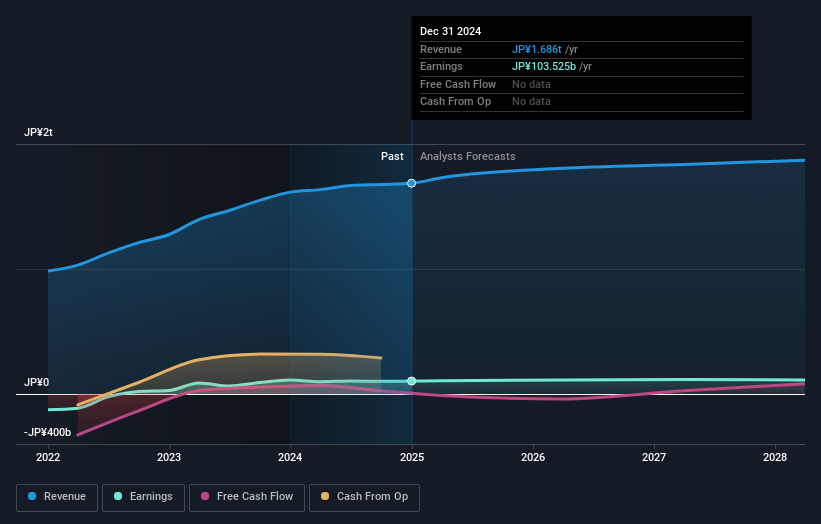Institutions profited after West Japan Railway Company's (TSE:9021) market cap rose JP¥66b last week but individual investors profited the most
Key Insights
- Significant control over West Japan Railway by individual investors implies that the general public has more power to influence management and governance-related decisions
- A total of 25 investors have a majority stake in the company with 39% ownership
- Institutional ownership in West Japan Railway is 42%
A look at the shareholders of West Japan Railway Company (TSE:9021) can tell us which group is most powerful. And the group that holds the biggest piece of the pie are individual investors with 56% ownership. Put another way, the group faces the maximum upside potential (or downside risk).
While individual investors were the group that benefitted the most from last week’s JP¥66b market cap gain, institutions too had a 42% share in those profits.
In the chart below, we zoom in on the different ownership groups of West Japan Railway.
Check out our latest analysis for West Japan Railway

What Does The Institutional Ownership Tell Us About West Japan Railway?
Many institutions measure their performance against an index that approximates the local market. So they usually pay more attention to companies that are included in major indices.
West Japan Railway already has institutions on the share registry. Indeed, they own a respectable stake in the company. This implies the analysts working for those institutions have looked at the stock and they like it. But just like anyone else, they could be wrong. When multiple institutions own a stock, there's always a risk that they are in a 'crowded trade'. When such a trade goes wrong, multiple parties may compete to sell stock fast. This risk is higher in a company without a history of growth. You can see West Japan Railway's historic earnings and revenue below, but keep in mind there's always more to the story.

West Japan Railway is not owned by hedge funds. Looking at our data, we can see that the largest shareholder is BlackRock, Inc. with 7.4% of shares outstanding. In comparison, the second and third largest shareholders hold about 3.8% and 3.6% of the stock.
On studying our ownership data, we found that 25 of the top shareholders collectively own less than 50% of the share register, implying that no single individual has a majority interest.
Researching institutional ownership is a good way to gauge and filter a stock's expected performance. The same can be achieved by studying analyst sentiments. There are a reasonable number of analysts covering the stock, so it might be useful to find out their aggregate view on the future.
Insider Ownership Of West Japan Railway
The definition of an insider can differ slightly between different countries, but members of the board of directors always count. Company management run the business, but the CEO will answer to the board, even if he or she is a member of it.
I generally consider insider ownership to be a good thing. However, on some occasions it makes it more difficult for other shareholders to hold the board accountable for decisions.
Our information suggests that West Japan Railway Company insiders own under 1% of the company. It is a very large company, so it would be surprising to see insiders own a large proportion of the company. Though their holding amounts to less than 1%, we can see that board members collectively own JP¥327m worth of shares (at current prices). It is good to see board members owning shares, but it might be worth checking if those insiders have been buying.
General Public Ownership
The general public -- including retail investors -- own 56% of West Japan Railway. This level of ownership gives investors from the wider public some power to sway key policy decisions such as board composition, executive compensation, and the dividend payout ratio.
Next Steps:
It's always worth thinking about the different groups who own shares in a company. But to understand West Japan Railway better, we need to consider many other factors. For example, we've discovered 2 warning signs for West Japan Railway that you should be aware of before investing here.
But ultimately it is the future, not the past, that will determine how well the owners of this business will do. Therefore we think it advisable to take a look at this free report showing whether analysts are predicting a brighter future .
NB: Figures in this article are calculated using data from the last twelve months, which refer to the 12-month period ending on the last date of the month the financial statement is dated. This may not be consistent with full year annual report figures.
Have feedback on this article? Concerned about the content? Get in touch with us directly. Alternatively, email editorial-team (at) simplywallst.com.
This article by Simply Wall St is general in nature. We provide commentary based on historical data and analyst forecasts only using an unbiased methodology and our articles are not intended to be financial advice. It does not constitute a recommendation to buy or sell any stock, and does not take account of your objectives, or your financial situation. We aim to bring you long-term focused analysis driven by fundamental data. Note that our analysis may not factor in the latest price-sensitive company announcements or qualitative material. Simply Wall St has no position in any stocks mentioned.
 Wall Street Journal
Wall Street Journal